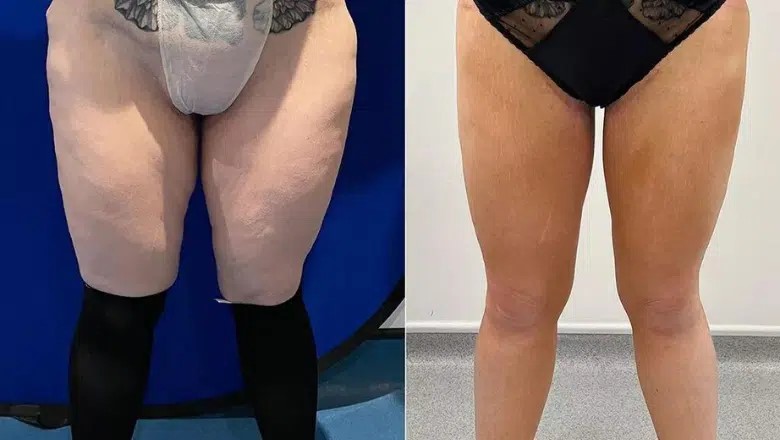What is thigh lift surgery?
A thigh lift procedure, also known as thighplasty, is a form of cosmetic surgery specifically designed to address the issue of excess, saggy skin in the thigh region. This condition is often a result of substantial weight loss. The primary goal of the procedure is to excise droopy skin and unnecessary fat tissue, thereby enhancing the natural contours of the thigh.
Following a thigh lift procedure, patients can expect firmer, smoother thighs with a more naturally curved appearance. The surgical scars are typically well-concealed within the body’s natural folds, making them less noticeable over time.
In many instances, the thigh lift procedure is performed in conjunction with liposuction. Liposuction aids in the removal of stubborn fat deposits that might be difficult to eliminate solely through a surgical incision. These two procedures, when executed together, can provide superior results, offering a comprehensive solution to reshape and refine the contour of the thigh region.
A thigh lift procedure, particularly when combined with liposuction, has the potential to significantly improve the aesthetics of the thighs, resulting in increased comfort, improved confidence, and a broader choice of clothing options.
Who gets a thigh lift?
You may consider getting a thigh lift procedure if you lose a significant amount of weight. Major weight loss can lead to poor skin tone and loss of elasticity in areas that store excess fat, like your thighs. This can cause:
- Cellulite or lumpy, dimpled skin.
- Rashes or chafing.
- Bleeding and discoloration.
- Sagging skin.
Ideal candidates for thigh lift
Candidates considered ideal for a thigh lift procedure are those who meet certain eligibility criteria, which are defined to ensure the health and safety of the patient, both before and after the procedure. The surgeons at the Centre for Surgery meticulously evaluate each patient against these criteria to minimize the risk of severe post-operative complications.
The optimal candidate for a thigh lift procedure:
- Is in good physical and mental health: An individual’s overall health status significantly impacts the surgery’s success and the healing process. Therefore, candidates should be free from severe health conditions that could interfere with surgery or recovery.
- Has a substantial amount of excess saggy skin in the thigh region: The primary purpose of the procedure is to remove this excess skin, making this a crucial criterion.
- Is at or near their ideal body weight: Candidates should have a stable weight and a healthy plan in place to maintain it. Major fluctuations in weight after the procedure could compromise the results.
- Has no plans for significant weight gain or loss in the future: Dramatic weight changes can negatively affect the results of the procedure and potentially necessitate additional surgeries.
- Is a non-smoker or willing to cease smoking at least six weeks before and after the procedure: Smoking can interfere with the body’s healing process and increase the risk of complications.
- Is electing to undergo the procedure for personal reasons, not due to societal pressure or trends: It’s essential that the decision to have surgery comes from a place of self-improvement and not external influences.
- Is fully informed about the potential risks and complications associated with the procedure: Understanding the possible outcomes and complications ensures that the decision to proceed with surgery is well-informed.
Meeting these eligibility criteria is vital for ensuring your safety and maximizing the likelihood of achieving desirable results from your thigh lift surgery.
Benefits of the Thigh Lift Procedure
The thigh lift procedure is a cosmetic surgery offering numerous benefits, both aesthetically and functionally, impacting positively on your physical well-being, mental health, and overall body contour.
- Improved Physical Health: Excess, saggy skin often results in skin folds which are prone to irritation and rashes due to constant rubbing. These folds can also foster bacterial growth, increasing the risk of skin infections. A thigh lift procedure can effectively mitigate these issues by removing the excess skin.
- Enhanced Body Aesthetics: Having excess skin around your thighs can make finding well-fitting clothes a challenging task, potentially causing emotional distress and impacting self-esteem. By undergoing a thigh lift, you can eliminate this excess skin, resulting in firmer, more contoured thighs. This reshaping can significantly boost your confidence and improve your body image.
- Freedom in Clothing Choices: Post-procedure, you’ll enjoy the freedom to show off your legs in any outfit without the concern of saggy skin. The surgical scars are generally hidden within the natural folds of the leg and typically fade over time, making them less noticeable.
- Positive Social and Interpersonal Impact: The increased self-confidence and body satisfaction following a thigh lift can positively influence social interactions and interpersonal relationships. Feeling good about your body can radiate positivity and confidence, enhancing all areas of your life.
Preparing for a Thigh Lift
Centre for Surgery takes pride in having assisted a significant number of thigh lift patients across London and the UK in regaining their confidence to wear shorts, skirts, and bathing suits comfortably, fully embracing and showcasing their thighs.
We understand that the prospect of any surgical procedure can instill feelings of nervousness or apprehension in patients. To alleviate these concerns, our team of highly skilled surgeons devote time to comprehending each patient’s desires and expectations meticulously. They provide expert guidance regarding the potential outcomes of the surgery, clarifying what can realistically be achieved and what cannot. This comprehensive approach ensures the patient is fully aware of the potential benefits and risks associated with the procedure, thereby helping them feel secure and comfortable about their decision.
The consultation process involves a detailed physical examination and review of your medical history. It also includes an in-depth conversation about your surgical goals and aspirations. You will be encouraged to communicate your ideal aesthetic look.
Our surgeons will invest ample time in ensuring that both you and they have a thorough understanding of your desired outcomes. It is important to remember that while surgery can bring about substantial change, there may be limitations to what can be achieved. Hence, having a clear understanding of realistic outcomes is crucial.
The surgeon will perform a meticulous examination to ascertain the precise procedure or combination of procedures that will best serve your goals. In the context of a thigh lift, discussions will include the location of the incision and the potential need for liposuction. Collaboratively, you and your surgeon will finalise the procedure that best aligns with your aspirations, paving the way towards achieving your desired aesthetic results.
Preparing for Thigh Lift Surgery
As part of the preparation for your thigh lift surgery, your surgeon will provide you with a comprehensive set of instructions designed to ensure optimal surgical results. These guidelines will cover aspects like diet, hydration, and the intake of specific vitamins and medications.
If you are a smoker, it is crucial to cease smoking at least four weeks prior to the surgery and continue to abstain during the recovery period. This is because smoking can hinder proper healing by decreasing circulation, thereby potentially affecting the surgery’s outcome.
In addition, certain substances can increase bleeding during the procedure, so you may be advised to avoid aspirin, anti-inflammatory drugs, or specific herbal supplements in the weeks leading up to and following the surgery. Following these recommendations is critical in ensuring your safety during the surgery and enhancing the healing process post-operatively.
Thigh Lift Techniques
Inner (Medial) Thigh Lift
This is one of the most common types of thigh lift surgeries. It targets the inner thigh area, which can be difficult to tone even with targeted exercises. In an inner thigh lift, the surgeon makes an incision where the thigh meets the pubic area. Through this incision, they can remove excess skin and fat to achieve a tighter and more toned appearance. The scar is usually well-hidden in the natural folds of the body.
Outer (Lateral) Thigh Lift
This procedure focuses on the front and outer areas of the thigh. An incision is typically made along the line of a bikini or underwear, from the groin around the back of the body. The surgeon then lifts and tightens the skin in this area, which can help to improve the contours of the thighs and buttocks. This procedure can also help to reduce cellulite.
Inner (Medial) Thigh Lift with Liposuction
This procedure combines an inner thigh lift with liposuction to achieve more comprehensive results. The liposuction can remove larger amounts of fat, while the thigh lift tightens the skin. This procedure can be particularly beneficial for patients who have lost a significant amount of weight and have both excess fat and skin. The effects of this procedure extend further down the inner thigh than a thigh lift alone, providing a more complete transformation.
Each of these procedures can be customized to meet your specific needs and goals. During your consultation, your surgeon will discuss these options with you and help you decide which technique is best for you.
Thigh Lift Surgery
Thigh lift surgery is a day-case procedure under TIVA general anaesthesia. This means you can recover in the comfort of your own home later the same day. The procedure takes about 2-3 hours, depending on the amount of excess loose skin and whether additional liposuction needs to be performed. Thigh lift surgery uses a combination of 2 surgical methods to both reduce the size of the thigh and contour the thigh through the removal of skin. Liposuction is performed first, followed by surgical removal of excess skin.
The surgical removal or excision of excess thigh skin effectively treats the loose hanging folds of skin commonly found in the inner thigh region. The incision for a thigh lift is most commonly made on the inside of the thigh. An ellipse of redundant skin is surgically removed, followed by a small amount of liposuction to fine-tune the contouring of the area. Once the desired thigh reduction has been achieved, the surgeon will meticulously suture the thigh incisions to leave a cosmetically acceptable scar. Thigh lift surgery is a combination procedure that encompasses both the removal of excess fat deposits and the removal of redundant thigh skin to expertly contour the thigh, leaving a contoured and sculpted appearance that is firm to the touch.
Thigh lift surgery can be either a mini thigh lift or a full thigh lift. The difference is in the placement of the incisions. The surgeon may make a horizontal or vertical incision, depending on your thigh shape, the location of the excess skin and fat and your end goals. A mini thigh lift incision is located primarily in the groin fold with no extension down the thigh. A full thigh lift involves both the groin incision and the full-length incision down the thigh to address thigh skin laxity effectively. In either case, liposuction using the power-assisted technique is commonly employed to remove excess fat minimally invasively. The decision to perform liposuction will be determined by the amount of skin laxity and excess fat present. Those with better skin quality may benefit more from liposuction as their skin envelope will be able to contract down more effectively on the newly reduced thigh contour. Massive weight loss patients will benefit more from a primarily surgical skin removal technique as liposuction may worsen any significant pre-existing skin laxity. At the end of the thigh lift procedure, the surgeon will use dissolvable sutures, which eliminate the need for separate suture removal, and a sterile dressing will be applied. A specialist compression garment will be applied to reduce the amount of bruising and swelling and protect the incisions from unintended trauma.
Principles of successful thigh lift surgery
Thigh lift surgery can be a complex procedure, and it is essential to choose a highly experienced body contouring surgeon to get the best results. The success of thigh lift surgery is determined by both thigh symmetry and potential scarring after thigh reduction surgery.
- Your surgeon takes preoperative planning very seriously to make sure that outcomes after the thigh lift are optimal. Obtaining a symmetrical result is a function of accurate preoperative markings and using delicate surgical techniques to minimise the risk of bleeding. Our surgeons often see patients who have had thigh lift surgery performed elsewhere and have had unsymmetrical results. Revision thigh lift surgery using fat grafting and sometimes skin grafting is required to address the asymmetry.
- Thigh lift surgery results in a significant scar burden. Despite this, our surgeons carefully place incisions in natural skin folds to minimise visible scarring. Thigh lift scars take several months to mature fully. At Centre for Surgery, our specialists access the full range of scar treatments to optimise the appearance of thigh lift scars.
Thigh Lift Risks & Complication
While thigh lift surgery is generally considered safe when performed by a qualified and experienced plastic surgeon, like any surgical procedure, it carries certain potential risks and complications. It’s important to understand these potential risks before proceeding with the surgery. Here are some of the potential risks and complications associated with a thigh lift procedure:
- Allergic reactions: As with any procedure that requires anaesthesia, there is a small risk of an allergic reaction to the anaesthetic used.
- Bleeding: There is always a risk of bleeding with any surgical procedure. However, surgeons take great care to minimize this risk during the operation.
- Seroma or fluid accumulation: This is a common complication of many types of surgery. Seromas are pockets of clear bodily fluids that can develop under the surface of the skin. They may require drainage if they don’t resolve on their own.
- Persistent pain and bruising: Some level of pain and bruising is normal after surgery, but if pain persists or is severe, it could signal a problem.
- Persistent numbness: It’s normal to experience some level of numbness after surgery due to nerve trauma. However, in rare cases, this numbness can become persistent.
- Infection: As with any surgical procedure, there is a risk of infection. Surgeons take several precautions to minimize this risk.
- Asymmetry: While surgeons aim for symmetry, the human body is naturally asymmetrical, and there may be minor differences in the appearance of each thigh after surgery.
- Damage to surrounding structures: While rare, there is a potential for injury to surrounding tissues, nerves, or muscles during surgery.
- Fat necrosis: This is a condition where the fat cells die, resulting in firm lumps. This is relatively rare but can occur.



























